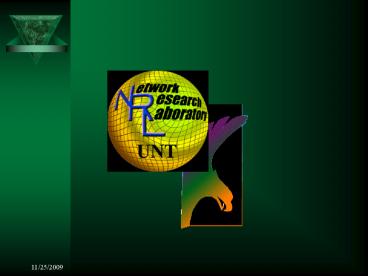Mobile Agent Applications PowerPoint PPT Presentation
1 / 42
Title: Mobile Agent Applications
1
(No Transcript)
2
The Role of Intelligent Mobile AgentsinNetwork
Management and Routing
- Masters Thesis
- University of North Texas, Denton
- Vinay Balamuru
- August 2000
3
Acknowledgments
- Dr. Armin Mikler
- Dr. Paul Tarau
- Dr. Robert Renka
- Dr. Tom Jacob
- CS / CAS / NRL System Administrators
- Friends and Colleagues
4
Scope of the Research
- Investigate the utility of intelligent mobile
agents in network management - Routing
- Knowledge Acquisition
- Compare the agent approach with the
conventional approach - Develop a working mobile agent system
5
Mobile Agent Crash Course
- Agent - entity which can perform a task
- Mobile Agent - an agent which can move around the
network (code , state, location) - Intelligent Mobile Agent - a mobile agent which
can make decisions about which action to perform
and when - We propose that agent systems be incorporated at
the system level
6
A Typical Mobile Agent System
server
Network node
launcher
Mobile agent
7
Mobile Agents Today
- Current Systems Agent Tcl, TACOMA, Aglets,
Jinni, etc. - wide range of application areas
- offer an alternative to traditional RPC /
client-server computational paradigm - Killer App ???
8
Advantages of Mobile Agents
- Computations are local
- Lower network traffic overhead
- can easily be adapted to perform a variety of
tasks - naturally suited for distributed activities
- autonomous
- collaborative
9
Limitations of Mobile Agents
- A mobile agent is a virus (worm)
- security
- The absence of a killer application
- Can take longer to achieve desired results in
certain cases
10
Overview of Distance Vector Routing (DVR)
- Packet Routing
- Cheapest paths for packets travelling between
nodes (routing tables) - Each node compares its routing tables with that
of its neighbours and adjusts the appropriate
entries accordingly - Eventually, complete routing info is obtained and
maintained at every node
11
Agent-based Routing (DVR)
- Agents carry the routing tables between nodes
- Fixed agent population
- Random agent motion
- Comparative basis between conventional distance
vector routing and agent routing - 1 routing message 1 agent hop
12
Varying Number of Agents
Few agents
Many agents
Distance vector
13
Varying Number of Agents
Distance vector
Few agents
14
Varying Network Size
Large network
Small network
Agents better than conventional DVR (here)
15
Varying Topology
- The maze problem
- Where is it more likely that you will find more
new paths - In a complex maze (denser graph)?
- In a simple maze (sparse graph)?
16
Varying Topology (Grid)
Distance vector
Agents
17
Varying Topology (Ring)
Agents
Distance Vector
18
Results
- For a network of size n
- Agents require less traffic to route
- Agents take longer time (previous research)
- number of agents O(n)
- number of routing messages O(n2)
- Agent routing times can be improved by
structuring the agent motion (previous research)
19
Knowledge Acquisition and Network Management
- Conventional method
- polling all the nodes for information
- generates a large amount of network traffic
- Agent Wave Computation
- self regulating
- scaleable
20
Agent Wave Computation
- Dynamic Agent Population Control
- Expansion - Contraction
- New information discovered
- Clone (probability) OR
- Roam
- No new Information discovered
- Merge (decrement counter) OR
- Expire
21
Varying Topology
Dense graph
Sparse graph
22
Varying Topology
Dense graph
Sparse graph
23
Varying Network Size (Grid)
Large Network
Small Network
24
Varying Network Size (Grid)
Large Network
Small Network
25
Variation in Initial Agents
26
Controlling Agent Population
- Reduced Fertility (tendency to clone)
- constant
- time dependent fertility
- Fertility dependent on geometry
27
Varying Agent Fertility
High Fertility
Low Fertility
28
Varying Agent Fertility
29
Time Dependent Fertility(t1-f)
30
Time Dependent Fertility(t1-f)
No Decay
Medium Decay
Fast Decay
31
Time Dependent Fertility
No Decay
MediumDecay
???
Fast Decay
32
Geometry-dependent Fertility
33
Geometry-dependent Fertility
34
Dynamically changing Networks
- Q. Can agents cope with constantly changing
network information and provide an accurate
picture of network information? - A. Yes and No
35
Changing Information
Unstable
Semi-stable
Stable
36
Results
- Distributed Knowledge Acquisition
- Scaleable Agent Population Control
- Several modifications to minimize population
explosion - reduced overall fertility
- fertility decay
- knowledge of network geometry
37
Features of the developed Agent System
- Java
- cross platform
- separation of agent code and state
- Mobile Serialized Objects
- Central or Distributed Class Server Model
- Secure
- Agent Class Caching
- lower network traffic
38
Architecture of the developed Agent System
Class server (can also exist on each agent
server)
C
Agent server
Cached class
C
Network node
launcher
Mobile agent
39
Object Diagram
40
Summary
- Mobile Agents route slower than conventional
methods - Mobile Agents use less network bandwidth in
routing - Mobile Agents could successfully be used in
network knowledge acquisition - Agents could be incorporated as a mobile
sub-layer at the system level
41
Further Work
- Agent Behavioural Model Development
- Agent Model Simulation
- Further development of Agent Platforms
- Application-level Development
- cluster management
- knowledge acquisition
- routing
- fault tolerance
- security
42
(No Transcript)

